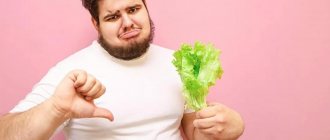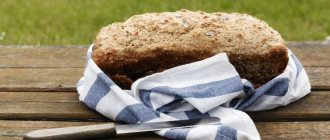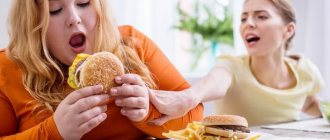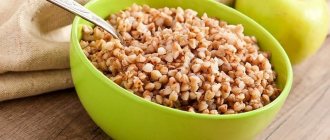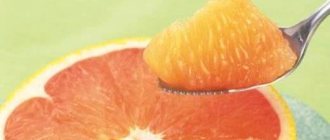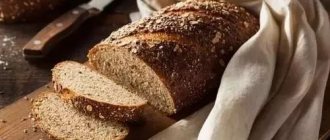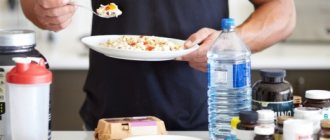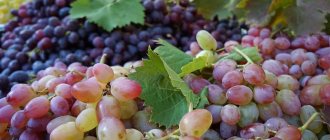The essence of the bread diet
The bread and water diet is one of the author's nutritional systems. It was developed by the famous Israeli nutritionist Olga Raz. The starting point for her research was the fact that most modern dietary systems limit carbohydrates. The process of losing weight on a low-carb diet is accompanied by a sharp drop in the level of serotonin in the body - the “happiness hormone”. This makes it difficult to stay on a diet, creates psychological problems, leads to breakdowns and compulsive overeating. Carbohydrates are necessary for a satisfactory psychological state and good mood. But there was a strict axiom that they were the main obstacle to losing weight.
An Israeli nutritionist went the opposite way, trying to create a dietary system based on carbohydrate foods. She succeeded, and this is how Olga Raz’s bread diet appeared.
Advice from nutritionists: how to lose 10-12 kg on a bread diet without harm to health
Diet is discipline in nutrition and compliance with certain rules, so the effect without harm to the body can be achieved if:
- before losing weight, assess the capabilities and condition of the body;
- follow a meal schedule (eat at the same time 3-4 times a day);
- draw up a menu for the entire duration of the course and strictly adhere to it;
- do not forget to drink mineral water without gas, spring or purified with a filter every day, at least 2 liters, in hot weather - up to 3 liters;
- move from a diet to a normal diet gradually, and continue to adhere to the norms of proper nutrition;
- replace active or heavy physical activity with light exercise;
- people leading a sedentary lifestyle should get into the habit of doing morning exercises.
A diet focused on bread and water is considered to be long-term in effectiveness; for about 2 years, there is no need for a radical change in lifestyle due to the desire to lose weight. Anyone can check from personal experience how accurate these terms are. The main thing is to do it correctly.
Bread diet rules
The bread food system has clearly defined rules that require mandatory implementation:
- The main dietary product is whole grain bread, with the addition of bran.
- It is allowed to use black rye bread or diet bread.
- Meals are small and frequent (5-6 meals per day).
- Fixed time limits for meals.
- The time interval between each dose is 3-4 hours.
- Skipping any meal is prohibited; you need to eat the planned portion, even if you really don’t want to.
- The drinking regime is standard - at least 2 liters per day of clean still water.
- During the entire period, taking a multivitamin complex and a calcium supplement is indicated.
- No white bread, no baked goods, no pastries!
Survive on only one food item
From bread baskets on a restaurant table to fluffy loaves, bread is included in many, if not most, dishes around the world.
Everyone loves carbohydrates, especially in bread. So wouldn't it be great if we could literally live on this favorite food group?
The short answer is no, you can’t eat bread alone!
Humans could probably survive on quality whole grain bread that would have been fermented over time. But they will eventually become malnourished and, in all likelihood, eventually tire of the carbohydrate-only substance.
Many people have wondered if humans can survive on just one food item.
The question is really interesting: if there is only one bread or any product it will probably save a lot of time and effort and possibly money. In addition, many foods contain significant amounts of excess nutrition.
But no one can contribute to everything, which is the main reason why humans evolved to eat a varied diet.
For example, potatoes technically contain all the essential amino acids needed for survival. But many of these amino acids are present in such small quantities that even if you consume many more calories per day through potatoes, you will end up with many nutritional deficiencies.
Permitted products and recommendations for their use
The bread diet is not as strict as it seems when you hear its name. In fact, a number of products are allowed, in addition to the main one. Allowed:
- vegetables in raw and processed (boiled, stewed, baked, steamed) forms, except those containing starch;
- unsweetened fruits (with the exception of bananas and grapes) are allowed once a day;
- fermented milk products (cottage cheese, kefir, yogurt, fermented baked milk, yogurt) with a low fat content. Limit – up to 200 g per day.
There is one important rule that needs to be mentioned separately. Yet proteins are so important for the human body that even a frankly carbohydrate-based nutritional system cannot ignore them. Three times a week it is necessary to replace one of the bread meals with a protein meal, including 150-200 g of lean meat or fish. On the same day at another time, one boiled chicken egg is eaten. This is necessary to supply the body with necessary microelements and amino acids, and to prevent muscle loss.
Vegetable salads are seasoned with a small amount of olive or flaxseed oil; lemon juice is used instead of spices and salt.
Kefir, yogurt, and fermented baked milk are recommended to be included in the menu to prevent bloating, which often occurs when consuming large amounts of cereals.
Bread diet for weight loss menu for 7 days
To avoid severe stress for the body, it is important to ensure the intake of proteins, fats and carbohydrates without excess. This is the only way to reduce your body mass index.
Calculating body mass index is very simple: you need to divide your weight by your height squared, expressed in meters. If it turns out to be from 18.5 to 25, everything is fine. If the numbers are higher, then it’s time to lose weight.
The bread diet includes 5 meals. It alternates vegetable days, there should be 4 of them per week, as well as protein days (with fish or meat) - 3 days a week. This approach will ensure the supply of all important elements; there will be no deficiency in amino acids or fiber.
Vegetable day menu:
- Breakfast. Four slices of bread with a small amount of curd, grated carrots, unsweetened tea.
- Snack. A glass of any fermented milk drink or a small apple.
- Dinner. Stewed cabbage or mixed vegetables with 4 servings of bread and an egg, a glass of tomato, carrot or unsweetened fruit juice.
- First dinner. Vegetable salad, 4 slices of bread, thin soup without meat, green tea.
- Second dinner. Stewed or steamed vegetables, before bed a glass of fermented baked milk, yogurt without additives.
Protein day menu:
- Breakfast. Three slices of bread with coleslaw.
- Snack. A glass of any fermented milk product or one orange.
- Dinner. Sea fish or low-fat meat stewed with vegetables, 200 ml of vegetable juice.
- First dinner. Soup made only from vegetables, boiled cauliflower with 3 slices of bread and tea.
- Second dinner. A mixture of stewed vegetables. Before bed, 200 ml of tea or juice from a mixture of vegetables.
Fermented milk drinks (fermented baked milk, kefir, yogurt) should be without additives with a minimum fat content so as not to increase the calorie content of the diet. In the morning before breakfast you should take calcium and vitamin supplements.
Prohibited products
The following are strictly prohibited:
- any sugar-containing products, including honey;
- fermented milk products with medium and high fat content;
- fatty meat and fish;
- animal fats (butter, lard);
- smoked, salted, pickled, canned food;
- mayonnaise, ketchup, fast food;
- alcohol of any strength;
- carbonated drinks and canned juices.
Fasting days on rice or buckwheat
To spend a fasting day on rice or buckwheat, in the case of using buckwheat, you will need to pre-soak this product for 8 hours in a certain volume of water; in the case of using rice, you will simply need to boil the product. It is allowed to include carrots in the main menu, raw or after light cooking. During the day, it is necessary to consume a non-strictly defined amount of cereal; exceeding the daily norm is allowed.
Pros and cons of the diet
There are a number of aspects worth noting that can be classified as advantages:
- cost savings, the power system is relatively cheap;
- saves time, cooking takes only a few minutes;
- absence of uncomfortable feeling of hunger;
- being in a relatively good mood due to high levels of serotonin;
- high provision of the body with fiber and microelements, richly presented in cereal products (potassium, magnesium, iron, phosphorus, B vitamins).
The disadvantages include:
- the lack of the required amount of fats and proteins negatively affects the condition of the skin, hair, and contributes to the loss of muscle mass;
- fiber in large quantities can seriously irritate the intestines, causing gastrointestinal problems;
- slowing down metabolism, which can lead to a “boomerang effect” on output.
Two stages of the bread diet
The diet consists of two stages. The first stage lasts 14 days. It is carried out according to the stated rules and with the selection of the above-mentioned products. It is at this stage that the main weight loss is observed, which can reach 5-7 kg.
The second stage, lasting from 14 to 21 days, is designed to stabilize and consolidate the achieved result. At its core, it is a kind of way out of a strict diet, protecting against the “boomerang effect”. At this stage, the diet gradually expands, new products appear in it:
- cereals from which porridge is cooked (oatmeal is especially preferred);
- pasta made from durum wheat flour;
- potatoes (no more than 1 piece/day, baked);
- legumes (beans, lentils, soybeans);
- the proportion and frequency of fruit intake increases (up to 3 times a day).
If desired, the second stage can be extended to 30-40 days, while losing up to 25 kg.
How to quit the bread diet and consolidate the effect
The most dangerous period is when you go off the diet. At this stage, it is important not to lose your temper and not eat unhealthy foods that your body misses: sweets, cakes, fried foods, fast food. If you want to preserve the result obtained, you will have to forget about them.
After strict restrictions on food, you should gradually introduce new healthy foods over 2 weeks, replacing portions of bread with them. Instead of 2 slices, a serving of pasta or porridge, one boiled potato or legumes are allowed. Fresh fruits and vegetables should be consumed up to 3 times a day. This way the body will make up for the lack of vitamins and minerals.
A small increase in caloric intake should be compensated by physical activity, but not strength, but moderate: yoga, dancing, active walking.
First stage menu
The bread diet menu for the first stage can be divided into protein and protein-free options.
| Day | Eating | Sample menu |
| Regular (no protein) | Breakfast | Bread sandwich (3-4 slices) with low-fat spread, grated beets, green tea |
| Lunch | Apple, a glass of kefir or yogurt | |
| Dinner | Bread (4-5 slices), with low-fat spread, stewed cabbage, juice | |
| Afternoon snack | Bread sandwich (3-4 slices), with low-fat spread, vegetable salad with herbs, green tea | |
| Dinner | Stewed vegetables, fermented baked milk or kefir | |
| Protein | Breakfast | Bread sandwich (3-4 slices), with low-fat spread, stewed carrots, green tea |
| Lunch | Citrus fruit, a glass of kefir or yogurt | |
| Dinner | Lean meat (fish), stewed vegetables, juice | |
| Afternoon snack | Bread (3-4 slices), with low-fat spread, carrot and zucchini stew, green tea | |
| Dinner | Steamed cauliflower, fermented baked milk or kefir |
And what happens after?
Is it really necessary to abstain only during fasting? Of course not. Every person needs periodic rest and relaxation. No one can live in a fast paced life every day without taking breaks. That is why the church established special times for fasting.
But after spending 40 days in abstinence, you shouldn’t catch up on Easter and gorge yourself on meat and sweets. Everything should be in moderation so as not to lose the spiritual meaning of the holiday.
Second stage menu
A typical second stage menu might look like this:
| Day | Eating | Sample menu |
| 2nd stage | Breakfast | Bread sandwich (3-4 slices), with low-fat spread, oatmeal, green tea |
| Lunch | Citrus fruit, a glass of kefir or curdled milk | |
| Dinner | Bread (4-5 slices), with low-fat spread, chicken fillet with pasta, juice | |
| Afternoon snack | Boiled beans with herbs, apple or pear, green tea | |
| Dinner | Stewed vegetables with baked potatoes, fermented baked milk or kefir |
Types of bread diet
There are such types of diets based on bread and water.
Diet on black bread
In addition to Olga Raz’s system, there is another option for a cereal diet - a diet on black bread. Although this version does not quite live up to its name, in the sense that in addition to the black bread itself, the menu also contains other products - oatmeal, chicken breast, fermented milk products.
It looks something like this:
| Day | Eating | Sample menu |
| Any day | Breakfast | Oatmeal, boiled in water, slice of cheese |
| Dinner | Bread products (any quantity), chicken fillet | |
| Dinner | Brown bread, fermented baked milk or kefir (0.5 l) |
It is not recommended to practice this system for no more than 8 days; maximum weight loss can be up to 4 kg.
Bread-kefir diet
There is also a bread-kefir option in the arsenal of dietetics, which is considered one of the toughest. The menu for the day is extremely simple: 2 liters of water, 1 liter of kefir and 250 g of bread products. It is suggested to maintain this routine for no longer than 1 week, weight loss reaches 0.5 kg per day. It is not surprising that such a food option exists, because some people use kefir for dietary purposes.
Diet of bread units
Another option is based on the basis of counting carbohydrates consumed, where the unit of account is 1 XE (bread unit), equal to 10 grams. You can consume no more than 10XE per day, the calculation is carried out according to specially developed dietary tables.
Watermelon diet with black bread
This is a more gentle version of the pure watermelon diet. To lose weight, you need to eat 1 kg of watermelon for every 10 kg of body weight per day. This volume of sweet pulp is divided into 6 or 7 servings and supplemented with 2-3 slices of black (rye) bread per day. If you really want to eat, then another piece of cheese is allowed, no more than 50 g.
It is better not to drink water, so as not to increase the already considerable load on the kidneys.
A diet based on black bread and watermelon pulp is an exclusively seasonal way to lose weight, but it helps to lose up to 10 kg in 7 days, cleanse the body of toxins and excess salts. You shouldn't practice it for more than a week.
Cautions
To eliminate all possible risks, before deciding on this method of losing weight, you should make an appointment with a nutritionist.
You can repeat the diet no earlier than 2 months after the end of the previous cycle.
To maximize the prolongation of the achieved results, you should not consume baked goods even after going out, maintain a water regime, practice physical activity, especially walking in the fresh air, dancing, yoga, and swimming.
How to fast effectively?
Even if you don't believe in God, you can use this precious time to transform your life:
- Give up being too busy and devote more time to your family and communication with loved ones, visit your grandparents.
- Take time to plan things to organize your life. Try not to return to the frantic rhythm of life after fasting.
- Clean up your home and get rid of unnecessary things. You can throw away things you no longer use every day. As a result, in 40 days 40 such items will be collected.
- You may want to stop using social media, which itself is time-consuming.
- Participate in charity projects and help the poor.
Before fasting, priests often advise you to write on paper and list everything that you would like to get rid of in life. Lent is a great time to bring your ideas to life.
Reviews and results
Those who have overcome the bread and water diet share their results.
Olga, 47 years old:
To be honest, I didn’t believe it was possible to lose weight on bread and water? However, I am already at the second stage. The waist has already become 4 centimeters and 6 kilograms are gone.
Ira, 23 years old:
I got acquainted with this method when I was studying at the institute. Its budget was very important to me, and there was almost no time for cooking. So I had time to prepare for the exams, and I didn’t have to run around the canteens, and for my diploma defense I ordered a dress 2 sizes smaller.
Stanislav, 39 years old:
I decided to try this diet, but was faced with heartburn and serious stomach pain. It turned out that I had high acidity, so I had to start treating gastritis. Consult your doctor before starting.
On bread and water
Even as a child, I often heard about how their relatives instilled good manners in one or another of my peers. One boy, who was suspected of drinking alcohol, was given moonshine laced with some kind of rubbish by his father. As a result, he turned inside out for the whole day, but he acquired an aversion to alcohol for the rest of his life. Another guy, having caught him with a bull, forced him to smoke a whole pack of stunningly strong cigarettes - with the same effect, so that it would be discouraging. A girl who loved to pull cats by the tail was torn out by her mother with nettles - so that she would know how much the cat was hurting. And so on.
Such folk remedies caused horror among intelligent townspeople, because in their understanding, normal upbringing is when you politely say something to your child, and he understands everything the first time and does what is needed. Or he doesn’t do what he shouldn’t. And here is some kind of wild Middle Ages... And yet there is something to think about. No, I do not call for punishing with a belt someone who likes to hurt others, because, quite possibly, he does this precisely because someone else hurt him before, and now he is taking revenge for it. It's about something else. It’s just that in many cases a person can comprehend the true meaning of certain words only by feeling and experiencing it all on himself. Until then, alas, it will be just words and nothing more.
Hunger. What do children know about this? Only that sometimes they want to eat. And if this desire arises, you just need to ask or demand, and adults will definitely feed you. Moreover, which is typical, “hunger” is often understood as a vague desire to eat something tasty. And not just swallow some piece of bread or cracker.
By the way, about breadcrumbs. I myself, when at school age I read or heard from movie characters that people have to eat only crackers, I immediately imagined the product that my mother and grandmother regularly bought in the store - neat and crispy slices, sprinkled with sugar and poppy seeds. Why not eat them? I agree! Or, say, when in films about the war they mentioned how important it was for soldiers sitting in the trenches to drink boiling water from a tin mug, I imagined a beautiful metal mug that stands in the kitchen, containing aromatic tea, certainly sweet. With those same crackers.
Or take the phrase “on bread and water.” So I take a loaf of fresh fragrant bread, pour it into a glass of clean water and start eating. The bread may be black, the water may be mineral, but in any case it does not seem terrible to me. Simply because, firstly, I have never eaten only this, and secondly, I don’t know what kind of bread and what kind of water they fed those about whom they speak in books and films. But certainly not with rolls and loaves!
Against this background, stories about how people were hungry, malnourished, divided the last crust of stale bread among seven, suffered from thirst and endured other hardships were perceived, let’s say, rather abstractly. Sometimes, however, when it happened that a splinter was driven under a nail, a finger was cut, or a knee was seriously bruised, someone would say, what was it like for the pioneer heroes, revolutionaries or intelligence officers who were cruelly tortured by their enemies? It was many times more painful for them, but they held on and didn’t betray anyone! And you're limp and snotty because of some abrasion on your knee or a bump on your forehead! And I had to endure it. Although, to be honest, I still couldn’t wrap my head around how it was even possible to withstand this, when you hit the corner of the closet with your little finger and sparks came out of your eyes, and what if someone purposefully hit you on your fingers with a hammer, demanding to tell you everything? ?..
What am I getting at? Moreover, education is not only the right words, but also the opportunity to feel something and understand how ready you are for challenges, whether your will is as strong as you think, or whether you still have a lot to do to strengthen it . But it’s still easier to say words than to do anything. In addition, all this smacks of a terrible, medieval conscious desire to cause suffering to a child, to make him feel uncomfortable! But this is absolutely non-pedagogical, because adults in general and teachers in particular are obliged to create the most favorable atmosphere for children, where there is no place for negative emotions! Is not it?
Not this way. You can tell your students for a long time about how hard it was for those who came out of encirclement, fighting their way out of the cauldrons near Bialystok, Uman, Vyazma and Bryansk. Or in what terrible conditions the defenders of Sevastopol had to fight in the Inkerman adits. Or what it was like for those who ran barefoot from burning villages in winter to escape punitive forces. You can talk very convincingly about all this and much more, and children will listen with furrowed eyebrows and clenched teeth, because they still have imagination.
But try going on a hike with them. On nature. In the forest. And there you simply offer to do without food for at least a day. And in such a way that everyone is on an equal footing, without secret snacks or discreet chocolates. Doctors will confirm that this will not cause any harm to the child’s body. But each of them will be able to test what he is capable of and how he will behave in a difficult situation. As an option, you can offer the children to live in conditions of a limited diet, when only one cracker per person is allowed (only standard, rye!). And see what they will do with it.
Does it bother you to read all this? Do you think this is some kind of mockery, perversion? After all, why, one might ask, make life difficult for children when, on the contrary, we need to make it as safe, well-fed and fun as possible! But this, as I already said, is not violence, but a voluntary agreement. Those who do not agree can simply not go on a hike. In addition, if someone violates the agreement, this test can be interrupted at any time by drawing appropriate conclusions.
But we are afraid, I think, of something completely different - that in such a situation people may behave completely differently from the way we want, and show themselves in a completely different way than we thought about them. And this applies not only and not so much to children, but to all of us. Because quite often there are examples of how a person first makes solemn statements, promises and swears to behave this way and only that way, and then gives up everything and, unable to bear it, runs away, gives up, or backs down. Hence the numerous divorces (at first love for life, and a month later - “Sorry, we didn’t get along, we’d better break up!”). Hence the children returned to the orphanage, whom someone tried to adopt, but then changed their minds (“I was hoping that this would be a joy, but here it’s some kind of nightmare, no, let’s better replay the game!”). Hence, pets that have become unnecessary and thrown into the street (“When he was a cute puppy, it was so touching, but now he chews everything up and craps everywhere, I don’t need such a dog!”). And many many others…
However, there is another explanation, also quite understandable. After all, in order to educate someone by your own example, you must at least be able to set this example. Why would I start with myself in such an uncomfortable matter as the ability to voluntarily endure hardships and adversity? Do I already have enough of them to add too much? Why would I go on a hike with my children and ask them to go without food for a whole day or even more, if I personally don’t need to prove anything, unlike them, I know perfectly well what hunger is?
It's not about hunger... Ask any schoolchild if he likes to strictly follow the daily routine. In particular, go to bed at 22.00 and get up at 8.00. “No,” any schoolchild will say, “I like to sit in front of the screen until one in the morning and get up at eleven in the morning, this is my normal state.” And ask him to stay up all night. And then another whole day. Yes, yes, voluntarily, and while performing some duties at the same time. For example, collecting firewood, clearing the area around the tents, digging a ditch to drain rain. And this will be a completely different matter, a test of a fundamentally different kind than simply “staying late.” It is only in Mikhalkov’s poem that the child hates the word “sleep” and dreams of those times when he can go to bed at any time he wants. Or don't go to bed at all. But what will he do if he wants to sleep (and eat too!), but needs to stay awake? The test of insomnia is no less than the test of hunger. And, as doctors will again confirm, there will be no harm to a child’s body from not sleeping for one night. Therefore, we can offer them to go through this too. Voluntarily.
And again the question is - why? The argument “to give children a more or less realistic idea of what it was like for their valiant ancestors” is unlikely to convince a modern adult. After all, it was hard for the ancestors, who can argue, but why torture the guys? Why complicate their already difficult life, they already eat poorly and sleep poorly! Maybe, on the contrary, we need to provide them with the highest quality products, comfortable beds and other amenities, as they do in children's holiday camps? And give them a break from school life? May be. Although, I repeat, we are only talking about the fact that a person can comprehend certain complex matters only in a state of immersion in reality. Therefore, it makes sense not to force, but simply to invite him to experience for himself what others felt, and what he talks about so well. Agree - fine, no - well, we understand...
Now it is fashionable to say that during the period of study, every schoolchild should be offered to try themselves in a variety of activities and endeavors - in construction, amateur performances, intellectual and sports games, public speaking, and so on, this is career guidance. And if the child understands that he really likes this, then we will help the person find the meaning of life and understand what he wants. Okay, but why not offer him, during the period of training, to visit a variety of situations, albeit complex, but well modeled or choreographed, in order to experience and experience certain moments? This is no longer a professional, but a social orientation, which is no less important. The main thing is that adults do not remain on the sidelines.
In the end, when parents tell their children how harmful it is to sit at the computer for a long time, they are right exactly until the moment when they themselves once again, after a full day of work, open the browser again and set sail across the vastness of the networks. But you can simply offer children - no, not to starve and not to give up sleep, but just to spend the weekend without mobile phones, tablets, laptops, game consoles and TVs. And with them to withstand this severe test. Difficult? Still would! But this is precisely what education is...
